2022 HYUNDAI SONATA air condition
[x] Cancel search: air conditionPage 500 of 546
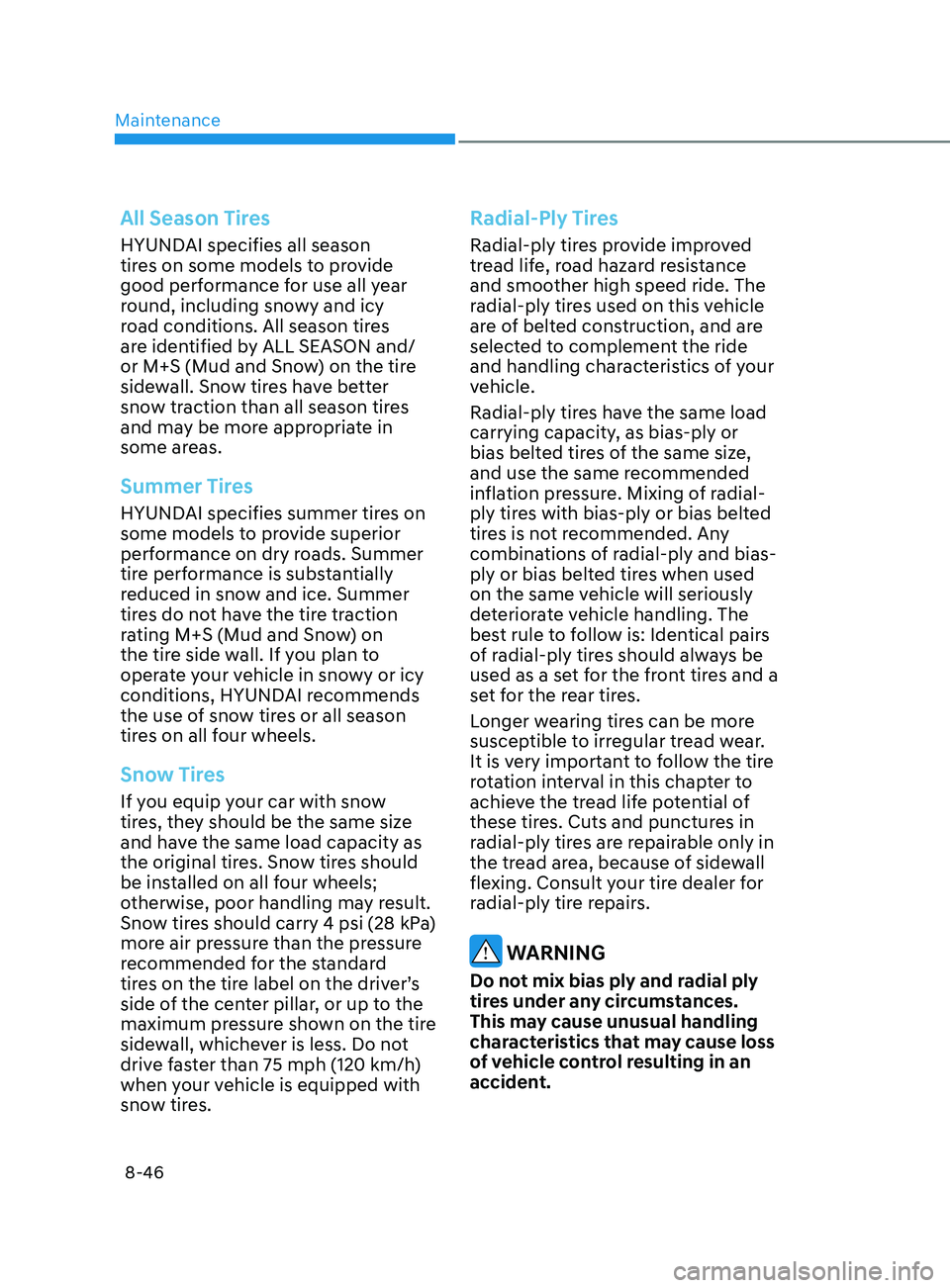
Maintenance
8-46
All Season Tires
HYUNDAI specifies all season
tires on some models to provide
good performance for use all year
round, including snowy and icy
road conditions. All season tires
are identified by ALL SEASON and/
or M+S (Mud and Snow) on the tire
sidewall. Snow tires have better
snow traction than all season tires
and may be more appropriate in
some areas.
Summer Tires
HYUNDAI specifies summer tires on
some models to provide superior
performance on dry roads. Summer
tire performance is substantially
reduced in snow and ice. Summer
tires do not have the tire traction
rating M+S (Mud and Snow) on
the tire side wall. If you plan to
operate your vehicle in snowy or icy
conditions, HYUNDAI recommends
the use of snow tires or all season
tires on all four wheels.
Snow Tires
If you equip your car with snow
tires, they should be the same size
and have the same load capacity as
the original tires. Snow tires should
be installed on all four wheels;
otherwise, poor handling may result.
Snow tires should carry 4 psi (28 kPa)
more air pressure than the pressure
recommended for the standard
tires on the tire label on the driver’s
side of the center pillar, or up to the
maximum pressure shown on the tire
sidewall, whichever is less. Do not
drive faster than 75 mph (120 km/h)
when your vehicle is equipped with
snow tires.
Radial-Ply Tires
Radial-ply tires provide improved
tread life, road hazard resistance
and smoother high speed ride. The
radial-ply tires used on this vehicle
are of belted construction, and are
selected to complement the ride
and handling characteristics of your
vehicle.
Radial-ply tires have the same load
carrying capacity, as bias-ply or
bias belted tires of the same size,
and use the same recommended
inflation pressure. Mixing of radial-
ply tires with bias-ply or bias belted
tires is not recommended. Any
combinations of radial-ply and bias-
ply or bias belted tires when used
on the same vehicle will seriously
deteriorate vehicle handling. The
best rule to follow is: Identical pairs
of radial-ply tires should always be
used as a set for the front tires and a
set for the rear tires.
Longer wearing tires can be more
susceptible to irregular tread wear.
It is very important to follow the tire
rotation interval in this chapter to
achieve the tread life potential of
these tires. Cuts and punctures in
radial-ply tires are repairable only in
the tread area, because of sidewall
flexing. Consult your tire dealer for
radial-ply tire repairs.
WARNING
Do not mix bias ply and radial ply
tires under any circumstances.
This may cause unusual handling
characteristics that may cause loss
of vehicle control resulting in an
accident.
Page 501 of 546

08
8-47
Low Aspect Ratio Tires
The aspect ratio is lower than 50 on
low aspect ratio tires.
Because low aspect ratio tires are
optimized for handling and braking,
their sidewall is a little stiffer than
a standard tire. Also low aspect
ratio tires tend to be wider and
consequently have a greater contact
patch with the road surface. In some
instances they may generate more
road noise compared with standard
tires.
CAUTION
Because the sidewall of a low
aspect ratio tire is shorter than
a standard tire, the rim of the
wheel and the tire itself is more
easily susceptible to damage. Use
caution when driving and follow the
guidelines below to help minimize
damage to the wheel and tire:
• When driving on a rough road
or off road, drive cautiously
because tires and wheels may
be damaged. And after driving,
inspect tires and wheels.
• When passing over a pothole,
speed bump, manhole, or curb
stone, drive slowly so that the
tires and wheels are not damaged.
• If the tire is subjected to a severe
impact, have the tire and wheel
inspected by an authorized
HYUNDAI dealer.
• Inspect the tire condition and
pressure every 1,800 miles
(3,000km).
CAUTION
• It is not easy to recognize tire
damage with your own eyes. But
if there is the slightest hint of tire
damage, have the tire checked or
replaced because the tire damage
may cause air leakage from the
tire.
• If the tire is damaged by driving
on a rough road, off road, pothole,
manhole, or curb stone, it will not
be covered by the warranty.
Page 520 of 546
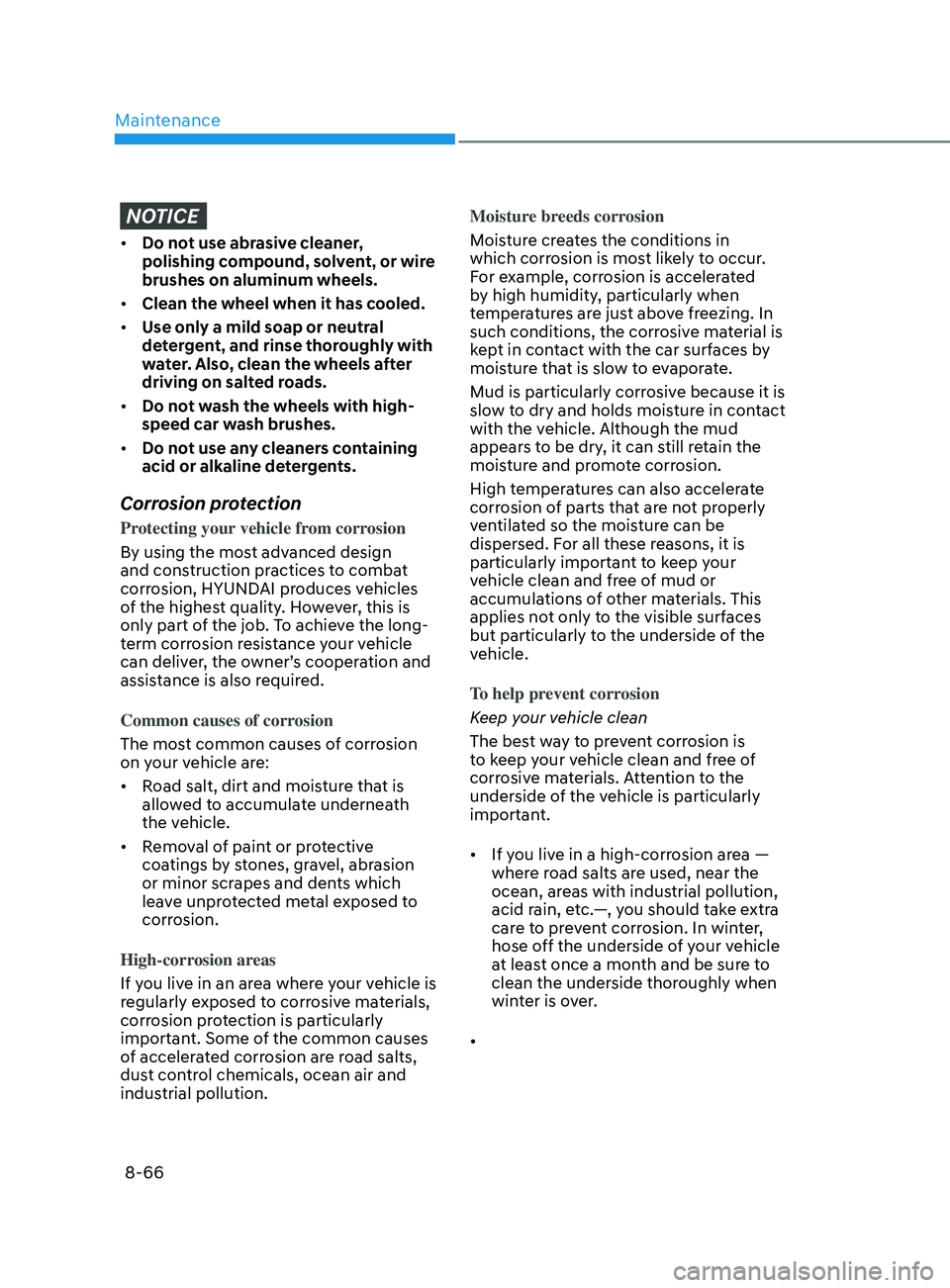
Maintenance
8-66
NOTICE
•Do not use abrasive cleaner,
polishing compound, solvent, or wire
brushes on aluminum wheels.
• Clean the wheel when it has cooled.
• Use only a mild soap or neutral
detergent, and rinse thoroughly with
water. Also, clean the wheels after
driving on salted roads.
• Do not wash the wheels with high-
speed car wash brushes.
• Do not use any cleaners containing
acid or alkaline detergents.
Corrosion protection
Protecting your vehicle from corrosion
By using the most advanced design
and construction practices to combat
corrosion, HYUNDAI produces vehicles
of the highest quality. However, this is
only part of the job. To achieve the long-
term corrosion resistance your vehicle
can deliver, the owner’s cooperation and
assistance is also required.
Common causes of corrosion
The most common causes of corrosion
on your vehicle are:
•Road salt, dirt and moisture that is
allowed to accumulate underneath
the vehicle.
• Removal of paint or protective
coatings by stones, gravel, abrasion
or minor scrapes and dents which
leave unprotected metal exposed to
corrosion.
High-corrosion areas
If you live in an area where your vehicle is
regularly exposed to corrosive materials,
corrosion protection is particularly
important. Some of the common causes
of accelerated corrosion are road salts,
dust control chemicals, ocean air and
industrial pollution. Moisture breeds corrosion
Moisture creates the conditions in
which corrosion is most likely to occur.
For example, corrosion is accelerated
by high humidity, particularly when
temperatures are just above freezing. In
such conditions, the corrosive material is
kept in contact with the car surfaces by
moisture that is slow to evaporate.
Mud is particularly corrosive because it is
slow to dry and holds moisture in contact
with the vehicle. Although the mud
appears to be dry, it can still retain the
moisture and promote corrosion.
High temperatures can also accelerate
corrosion of parts that are not properly
ventilated so the moisture can be
dispersed. For all these reasons, it is
particularly important to keep your
vehicle clean and free of mud or
accumulations of other materials. This
applies not only to the visible surfaces
but particularly to the underside of the
vehicle.
To help prevent corrosion
Keep your vehicle clean
The best way to prevent corrosion is
to keep your vehicle clean and free of
corrosive materials. Attention to the
underside of the vehicle is particularly
important.
•
If you live in a high-corrosion area —
where road salts are used, near the
ocean, areas with industrial pollution,
acid rain, etc.—, you should take extra
care to prevent corrosion. In winter,
hose off the underside of your vehicle
at least once a month and be sure to
clean the underside thoroughly when
winter is over.
•
Page 525 of 546
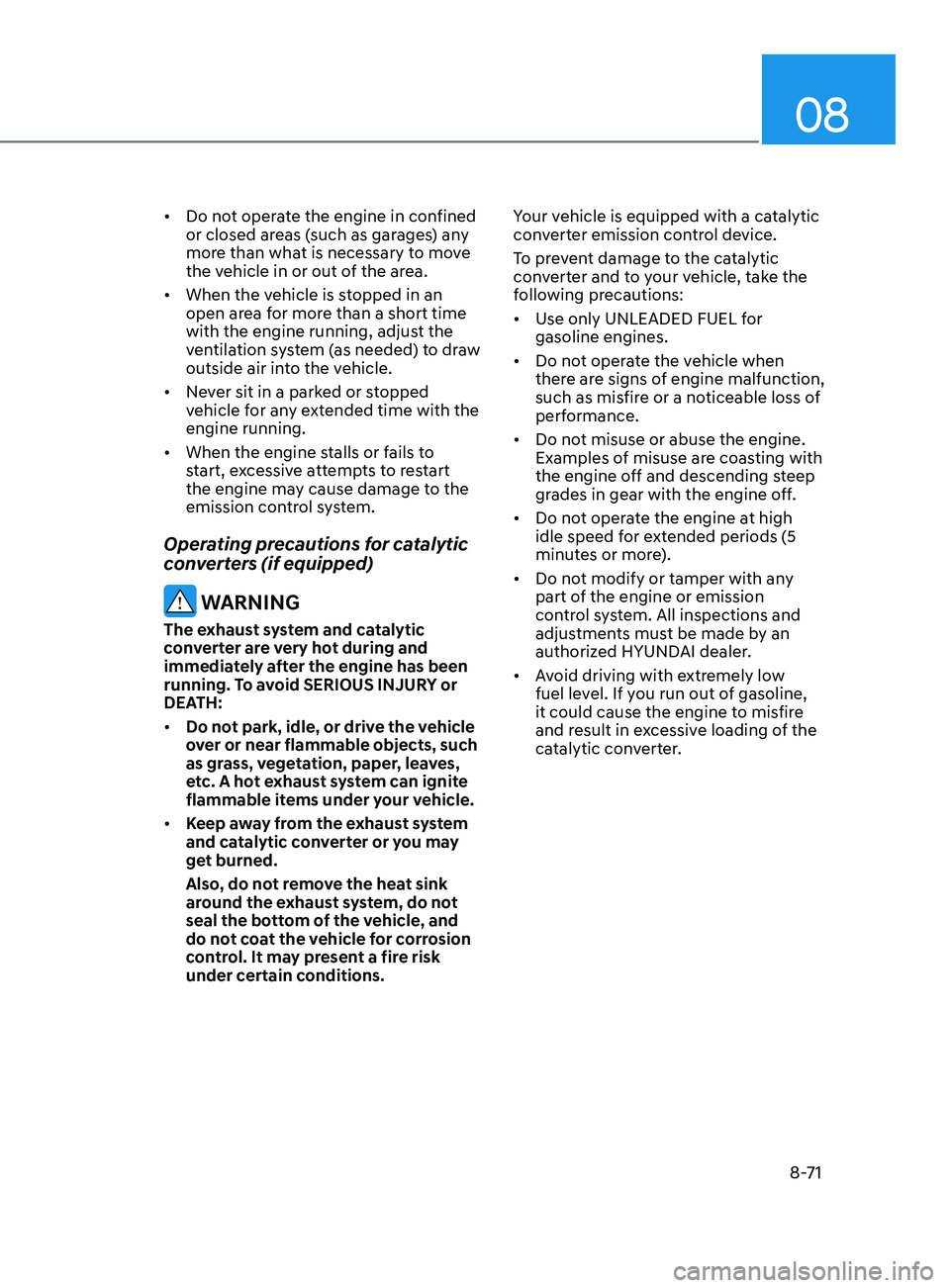
08
8-71
• Do not operate the engine in confined
or closed areas (such as garages) any
more than what is necessary to move
the vehicle in or out of the area.
• When the vehicle is stopped in an
open area for more than a short time
with the engine running, adjust the
ventilation system (as needed) to draw
outside air into the vehicle.
• Never sit in a parked or stopped
vehicle for any extended time with the
engine running.
• When the engine stalls or fails to
start, excessive attempts to restart
the engine may cause damage to the
emission control system.
Operating precautions for catalytic
converters (if equipped)
WARNING
The exhaust system and catalytic
converter are very hot during and
immediately after the engine has been
running. To avoid SERIOUS INJURY or
DEATH:
• Do not park, idle, or drive the vehicle
over or near flammable objects, such
as grass, vegetation, paper, leaves,
etc. A hot exhaust system can ignite
flammable items under your vehicle.
• Keep away from the exhaust system
and catalytic converter or you may
get burned.
Also, do not remove the heat sink
around the exhaust system, do not
seal the bottom of the vehicle, and
do not coat the vehicle for corrosion
control. It may present a fire risk
under certain conditions. Your vehicle is equipped with a catalytic
converter emission control device.
To prevent damage to the catalytic
converter and to your vehicle, take the
following precautions:
•
Use only UNLEADED FUEL for
gasoline engines.
• Do not operate the vehicle when
there are signs of engine malfunction,
such as misfire or a noticeable loss of
performance.
• Do not misuse or abuse the engine.
Examples of misuse are coasting with
the engine off and descending steep
grades in gear with the engine off.
• Do not operate the engine at high
idle speed for extended periods (5
minutes or more).
• Do not modify or tamper with any
part of the engine or emission
control system. All inspections and
adjustments must be made by an
authorized HYUNDAI dealer.
• Avoid driving with extremely low
fuel level. If you run out of gasoline,
it could cause the engine to misfire
and result in excessive loading of the
catalytic converter.
Page 530 of 546
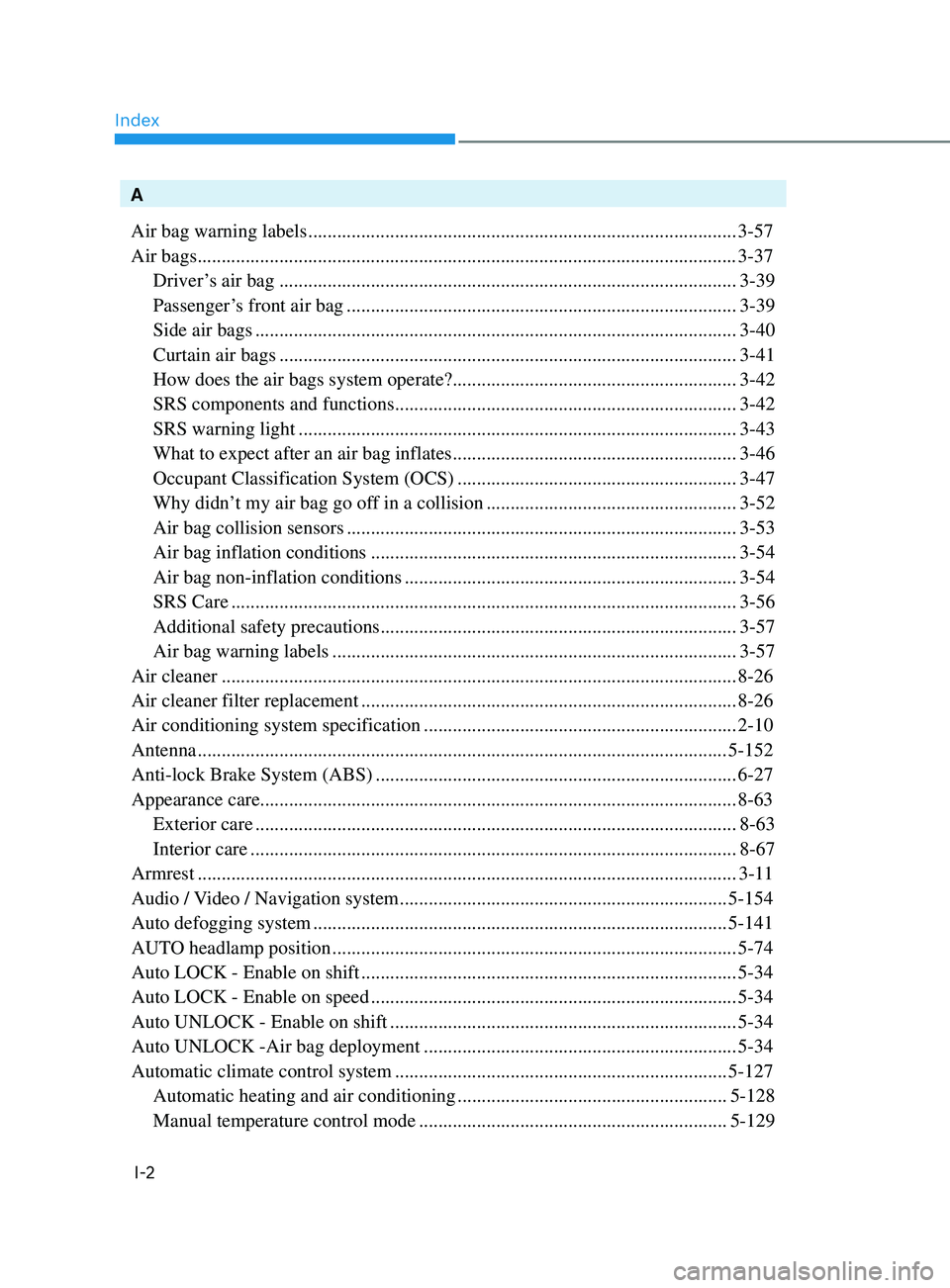
Index
I-2
A
Air bag warning labels
........................................................................\
................. 3-57
Air bags
........................................................................\
........................................ 3-37
Driver’s air bag
........................................................................\
....................... 3-39
Passenger’s front air bag
........................................................................\
......... 3-39
Side air bags
........................................................................\
............................ 3-40
Curtain air bags
........................................................................\
....................... 3-41
How does the air bags system operate?........................................................... 3-42
SRS components and functions
....................................................................... 3-42
SRS warning light
........................................................................\
................... 3-43
What to expect after an air bag inflates
...........................................................3-46
Occupant Classification System (OCS)
.......................................................... 3-47
Why didn’
t my air bag go off in a collision
....................................................3-52
Air bag collision sensors
........................................................................\
......... 3-53
Air bag inflation conditions
........................................................................\
.... 3-54
Air bag non-inflation conditions
..................................................................... 3-54
SRS Care
........................................................................\
................................. 3-56
Additional safety precautions
........................................................................\
.. 3-57
Air bag warning labels
........................................................................\
............ 3-57
Air cleaner
........................................................................\
................................... 8-26
Air cleaner filter replacement
........................................................................\
...... 8-26
Air conditioning system specification
................................................................. 2-10
Antenna
........................................................................\
...................................... 5-152
Anti-lock Brake System (ABS)
........................................................................\
... 6-27
Appearance care........................................................................\
........................... 8-63 Exterior care
........................................................................\
............................ 8-63
Interior care
........................................................................\
............................. 8-67
Armrest
........................................................................\
........................................ 3-11
Audio / Video / Navigation system
.................................................................... 5-154
Auto defogging system
........................................................................\
.............. 5-141
AUT
O headlamp position
........................................................................\
............ 5-74
Auto LOCK - Enable on shift
........................................................................\
...... 5-34
Auto LOCK - Enable on speed
........................................................................\
.... 5-34
Auto UNLOCK - Enable on shift
........................................................................\
5-34
Auto UNLOCK -Air bag deployment
................................................................. 5-34
Automatic climate control system
..................................................................... 5-127
Automatic heating and air conditioning
........................................................5-128
Manual temperature control mode
................................................................ 5-129
Page 531 of 546
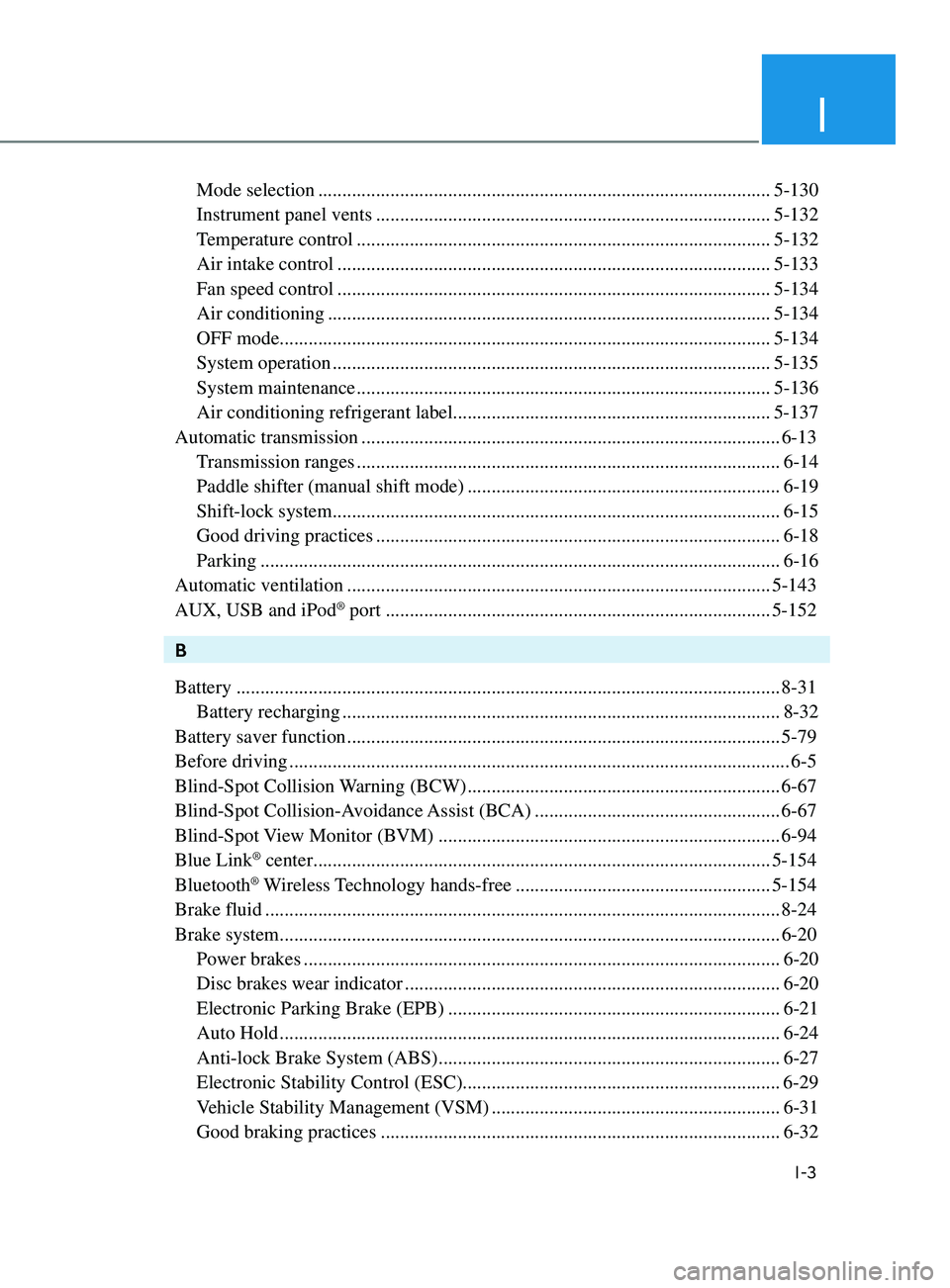
I
I-3
Mode selection ........................................................................\
...................... 5-130
Instrument panel vents
........................................................................\
.......... 5-132
Temperature control
........................................................................\
.............. 5-132
Air intake control
........................................................................\
.................. 5-133
Fan speed control
........................................................................\
.................. 5-134
Air conditioning
........................................................................\
.................... 5-134
OFF mode........................................................................\
.............................. 5-134
System operation
........................................................................\
................... 5-135
System maintenance
........................................................................\
.............. 5-136
Air conditioning refrigerant label.................................................................. 5-137
Automatic transmission
........................................................................\
............... 6-13
Transmission ranges
........................................................................\
................ 6-14
Paddle shifter (manual shift mode)
................................................................. 6-19
Shift-lock system
........................................................................\
..................... 6-15
Good driving practices
........................................................................\
............ 6-18
Parking
........................................................................\
.................................... 6-16
Automatic ventilation
........................................................................\
................ 5-143
AUX, USB and iPod
® port ........................................................................\
........ 5-152
B
Battery
........................................................................\
......................................... 8-31
Battery recharging
........................................................................\
................... 8-32
Battery saver function
........................................................................\
.................. 5-79
Before driving
........................................................................\
................................ 6-5
Blind-Spot Collision Warning (BCW)
................................................................. 6-67
Blind-Spot Collision-Avoidance Assist (BCA)
................................................... 6-67
Blind-Spot View Monitor (BVM)
....................................................................... 6-94
Blue Link
® center ........................................................................\
....................... 5-154
Bluetooth® Wireless Technology hands-free ..................................................... 5-154
Brake fluid
........................................................................\
................................... 8-24
Brake system
........................................................................\
................................ 6-20
Power brakes
........................................................................\
........................... 6-20
Disc brakes wear indicator
........................................................................\
...... 6-20
Electronic Parking Brake (EPB)
..................................................................... 6-21
Auto Hold
........................................................................\
................................ 6-24
Anti-lock Brake System (ABS)
....................................................................... 6-27
Electronic Stability Control (ESC).................................................................. 6-29
Vehicle Stability Management (VSM)
............................................................ 6-31
Good braking practices
........................................................................\
........... 6-32
Page 536 of 546

Index
I-8
Horn ........................................................................\
.............................................5-45
How to use this manual
........................................................................\
................. 1-4
Hyundai digital key........................................................................\
...................... 5-15 Digital key application
........................................................................\
............ 5-15
Digital key (smartphone) NFC function
.........................................................5-15
Digital key (smartphone)........................................................................\
......... 5-16
Digital key (card key)........................................................................\
.............. 5-23
I
If the engine doesn’t turn over or turns over slowly
.............................................. 7-3
If the engine overheats
........................................................................\
................... 7-6
If the engine stalls at a crossroad or crossing
........................................................7-2
If the engine stalls while driving
........................................................................\
... 7-2
If the engine turns over normally but doesn’t start
................................................7-3
If the engine will not start
........................................................................\
.............. 7-3
If you have a flat tire while driving
....................................................................... 7-3
Ignition switch
........................................................................\
............................... 6-6
Key ignition switch
........................................................................\
................... 6-6
Engine Start/Stop button
........................................................................\
........... 6-9
Remote start
........................................................................\
............................ 6-12
Immobilizer system
........................................................................\
..................... 5-14
Improtant safety precautions........................................................................\
.......... 3-2 Always wear your seat belt
........................................................................\
....... 3-2
Restrain all children
........................................................................\
.................. 3-2
Air bag hazards
........................................................................\
......................... 3-2
Driver distraction
........................................................................\
...................... 3-2
Control your speed
........................................................................\
.................... 3-2
Keep your vehicle in safe condition
.................................................................. 3-2
In case of emergency while driving
....................................................................... 7-2
Infotainment system........................................................................\
................... 5-152 AUX, USB and iPo
d® port ........................................................................\
..... 5-152
Antenna
........................................................................\
................................. 5-152
Steering wheel audio controls
....................................................................... 5-153
Bluetooth
® Wireless Technology hands-free ................................................. 5-154
Audio /
Video / Navigation system
............................................................... 5-154
Blue Link
® center ........................................................................\
.................. 5-154
Inside rearview mirror
........................................................................\
................. 5-46
Page 540 of 546
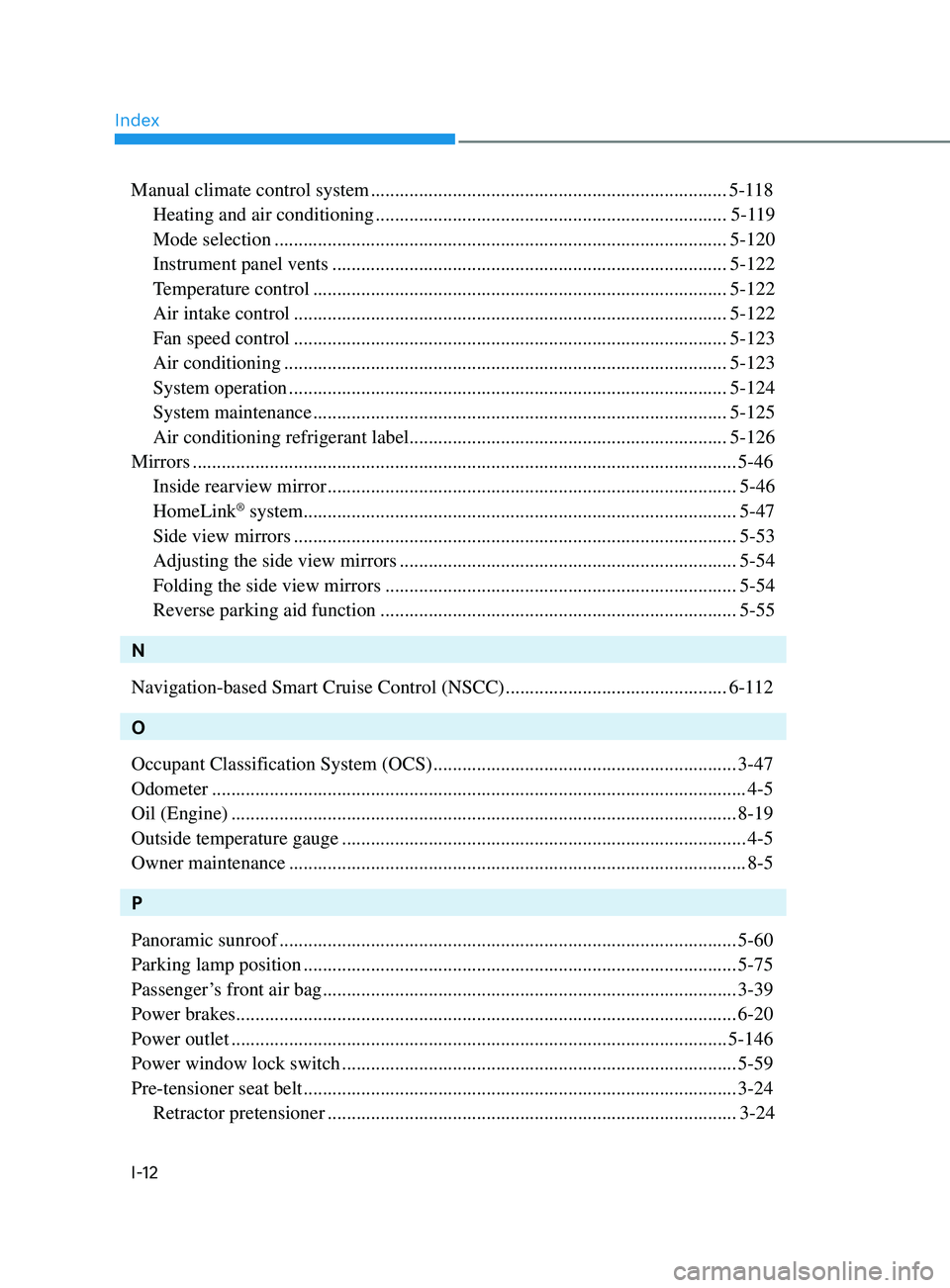
Index
I-12
Manual climate control system ........................................................................\
.. 5-118
Heating and air conditioning
........................................................................\
. 5-119
Mode selection
........................................................................\
...................... 5-120
Instrument panel vents
........................................................................\
.......... 5-122
Temperature control
........................................................................\
.............. 5-122
Air intake control
........................................................................\
.................. 5-122
Fan speed control
........................................................................\
.................. 5-123
Air conditioning
........................................................................\
.................... 5-123
System operation
........................................................................\
................... 5-124
System maintenance
........................................................................\
.............. 5-125
Air conditioning refrigerant label.................................................................. 5-126
Mirrors
........................................................................\
......................................... 5-46
Inside rearview mirror
........................................................................\
............. 5-46
HomeLink
® system........................................................................\
.................. 5-47
Side view mirrors
........................................................................\
.................... 5-53
Adjusting the side view mirrors
...................................................................... 5-54
Folding the side view mirrors
........................................................................\
. 5-54
Reverse parking aid function
........................................................................\
.. 5-55
N
Navigation-based Smart Cruise Control (NSCC)
..............................................6-112
O
Occupant Classification System (OCS)
............................................................... 3-47
Odometer
........................................................................\
....................................... 4-5
Oil (Engine)
........................................................................\
................................. 8-19
Outside temperature gauge
........................................................................\
............ 4-5
Owner maintenance
........................................................................\
....................... 8-5
P
Panoramic sunroof
........................................................................\
....................... 5-60
Parking lamp position
........................................................................\
.................. 5-75
Passenger’s front air bag
........................................................................\
.............. 3-39
Power brakes
........................................................................\
................................ 6-20
Power outlet
........................................................................\
............................... 5-146
Power window lock switch
........................................................................\
.......... 5-59
Pre-tensioner seat belt
........................................................................\
.................. 3-24
Retractor pretensioner
........................................................................\
............. 3-24